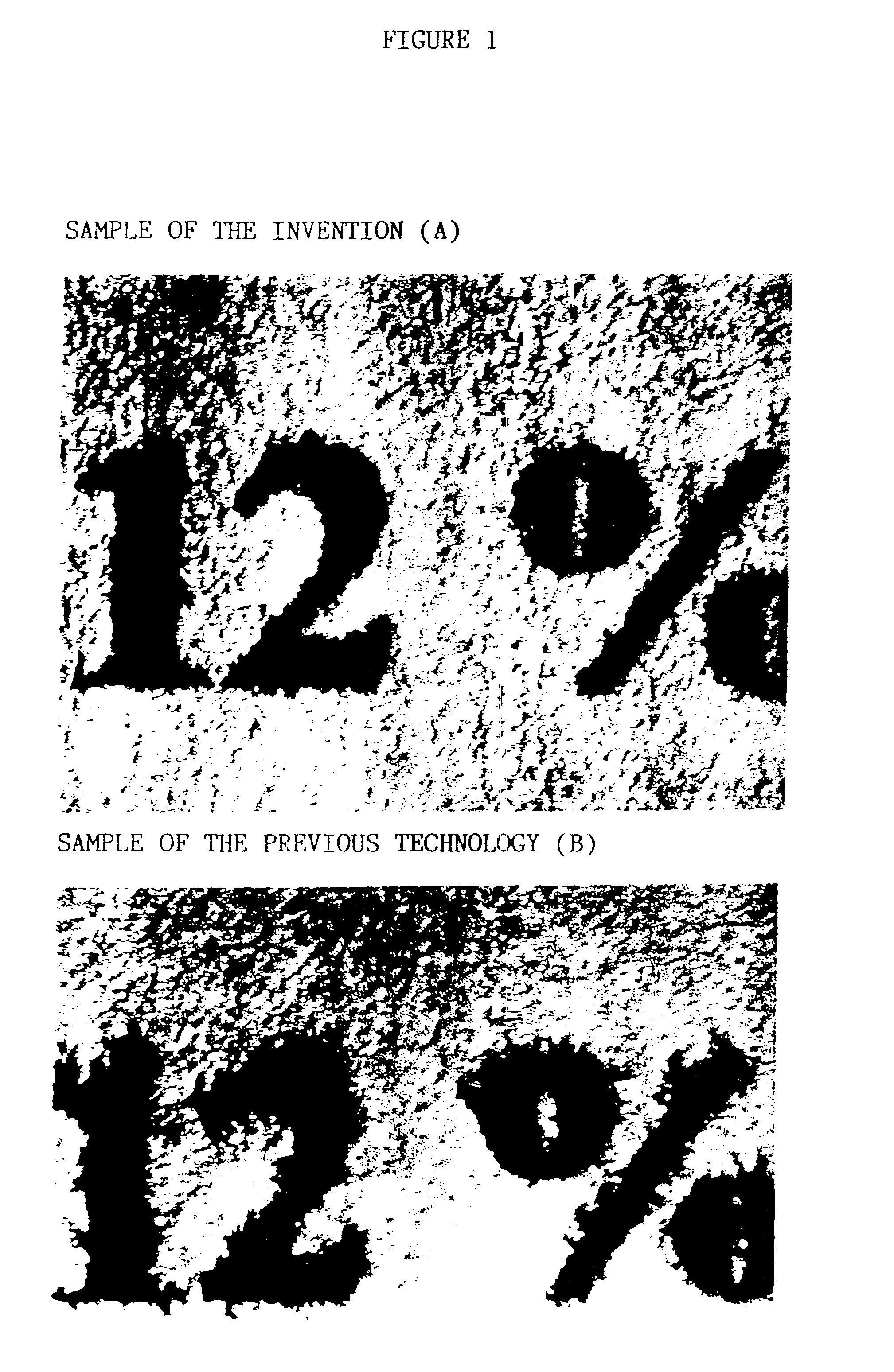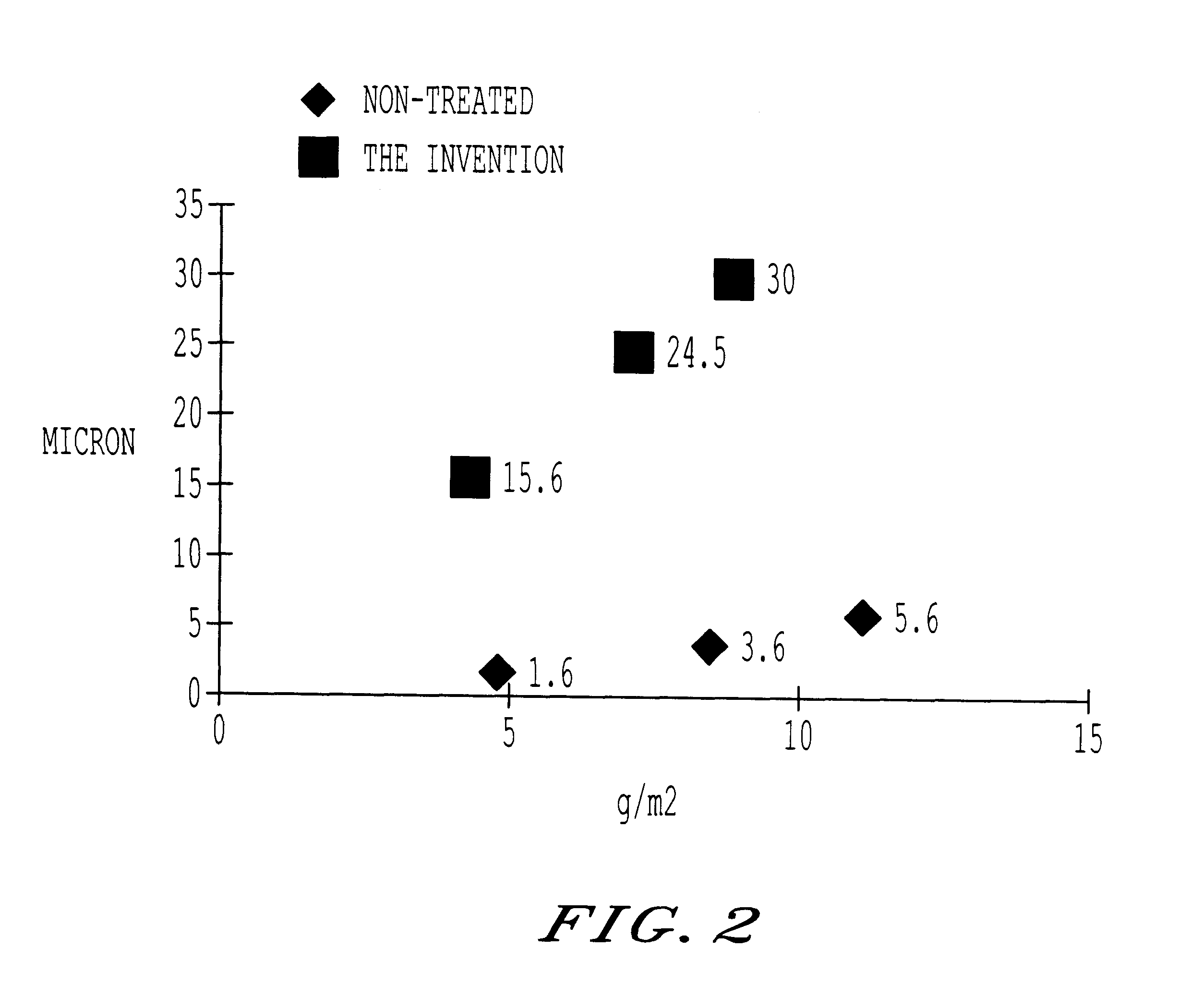Treated filler or pigment containing natural carbonate
a filler or pigment technology, applied in the field of natural carbonate treated filler or pigment, can solve the problems of loss of coating color and coated paper, complicated problem, and solution which does not provide energy saving
- Summary
- Abstract
- Description
- Claims
- Application Information
AI Technical Summary
Benefits of technology
Problems solved by technology
Method used
Image
Examples
example 2
This example concerns the treatment of slurries with a high dry matter content.
For all the tests of Example 2, the mineral is prepared in the form of a suspension ("slurry") of which the solid or dry matter content may be up to 80% by weight, or in the form of a filter cake, or in the form of a dry powder, in a suitable reactor. If necessary the preparation is diluted to the required level of dry matter using distilled water or tap water.
Test No. 15:
For the purposes of this test, which illustrates the prior art, an aqueous composition is prepared by introducing the following into a mixer under agitation:
750 dry grams of Norwegian marble with granulometry such that 75% of the particles have a diameter of less than 1.mu. measured using a Micrometrics Sedigraph 5100.TM. instrument
250 dry grams of a talc from Finland with granulometry such that 45% of the particles have a diameter of less than 2.mu. measured using a Micrometrics Sedigraph 5100.TM. instrument
5 dry grams of an acrylic bin...
example 3
This example involves using, with an ink jet printer, a treated or non-treated calcium carbonate as a filler in the paper.
We dilute 0.5 kg, calculated on the basis of dry pigment, of natural Norwegian marble calcium carbonate with granulometry such that 75% of the particles by weight have a diameter of less than 1.mu. measured using a Sedigraph 5100.TM. instrument from Micrometrics, in the form of a filter cake, using distilled water in the 10 liter container until a slurry is obtained with a concentration of 15% by weight of dry matter. The slurry thus formed is then treated using phosphoric acid in a solution of 10% by weight at 65.degree. C. under agitation for 20 minutes at 500 revolutions per minute. After 15 minutes CO.sub.2 is bubbled through the suspension for 1 hour.
Once CO.sub.2 bubbling is complete, sheets of paper are formed using as a filler the slurry of calcium carbonate to be tested.
In order to do this we make sheets of paper from a pulp or paste with an SR value of ...
example 4
This example involves using, with an ink jet printer, a treated or non-treated calcium carbonate as a filler in the paper and as a coating.
We dilute 0.5 kg, calculated on the basis of dry pigment, of natural Norwegian marble calcium carbonate with granulometry such that 75% of the particles have a diameter of less than 1.mu. measured using a Sedigraph 5100.TM. instrument from Micrometrics, in the form of a filter cake, using distilled water in the 10 liter container until a slurry is obtained with a concentration of 15% by weight of dry matter. The slurry thus formed is then treated using phosphoric acid in a solution of 10% by weight at 65.degree. C. under agitation for 20 minutes at 500 revolutions per minute. After 15 minutes CO.sub.2 is bubbled through the suspension for 1 hour .
Coating Protocol:
We use the same protocol as in Test 27 above i.e. the test sample is coated onto a wood-based paper 53 .mu.m thick with a grammage of 32.9 g / m.sup.2.+-.0.39%, using a laboratory coating ...
PUM
| Property | Measurement | Unit |
|---|---|---|
| Length | aaaaa | aaaaa |
| Length | aaaaa | aaaaa |
| Length | aaaaa | aaaaa |
Abstract
Description
Claims
Application Information
 Login to View More
Login to View More - R&D
- Intellectual Property
- Life Sciences
- Materials
- Tech Scout
- Unparalleled Data Quality
- Higher Quality Content
- 60% Fewer Hallucinations
Browse by: Latest US Patents, China's latest patents, Technical Efficacy Thesaurus, Application Domain, Technology Topic, Popular Technical Reports.
© 2025 PatSnap. All rights reserved.Legal|Privacy policy|Modern Slavery Act Transparency Statement|Sitemap|About US| Contact US: help@patsnap.com



